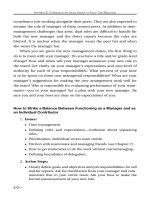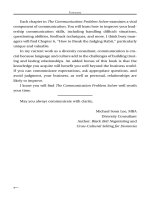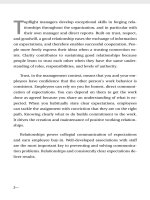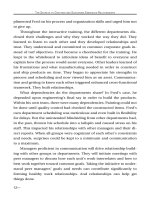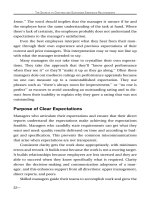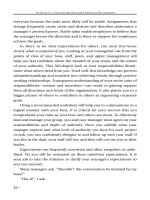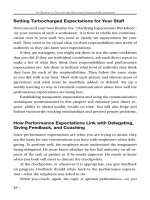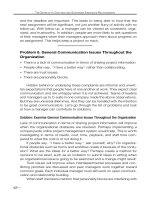The Communication Problem Solver 22 ppsx
Bạn đang xem bản rút gọn của tài liệu. Xem và tải ngay bản đầy đủ của tài liệu tại đây (75.64 KB, 10 trang )
L
EADING
C
OLLABORATIVE
C
ONVERSATIONS
‘‘Yes,’’ he continued. ‘‘I gave her some feedback two days ago. Then
she missed work the next day. She always calls in sick the day after I give
her feedback.’’
‘‘How did you give her the feedback?’’ I asked.
‘‘I sent her an e-mail.’’
‘‘Have you considered just talking to her in person instead of sending
feedback by e-mail?’’
‘‘No,’’ he replied. ‘‘She always talks on and on and I don’t have time
for that.’’
He told me the scenario, which sounded like a misunderstanding
about the expectation. It could easily have been handled in person in a
positive, brief, and gentle way. This manager had no training in giving
feedback, so he probably did not relate his comments in the e-mail to a
previously expressed expectation. In fact, the expectation was probably
not verbalized. Now feedback by e-mail was costing this small-business
owner one day’s salary for the absent employee, plus the cost of hiring a
temp for the front desk. So it put a ding in the finances as well as the
relationship. A collaborative conversation could have straightened out
the misunderstanding and led to an instantaneous solution.
Benefits of Feedback
When properly delivered, feedback benefits the direct report in many
ways. This communication aligns individual behavior and efforts with
organizational interests and success, which is why people are at work in
the first place. When an employee listens to feedback, she can develop
skills and knowledge and achieve success that might not be accom-
plished without feedback. As the employee garners a sense of accom-
plishment, she is energized to persevere when times get tough.
Letting employees know where they stand, on a continual basis, re-
duces fear of the unknown. Knowledge, of how they are meeting or not
meeting expectations, empowers employees to fine-tune their actions so
they can achieve. This presents employees with a chance to improve
192—
G
IVING
F
EEDBACK
—S
WEET OR
S
OUR
?
performance and make midcourse corrections, which shows the man-
ager has individuals’ best interests at heart.
Feedback develops partnerships between employee and manager. It
strengthens relationships as partners collaborate on reaching goals.
Feedback invites participation and offers an opportunity for employees
to voice their perspectives, concerns, and need for support. It offers the
manager the opportunity to gather information from direct reports and
collaborate on solutions. Collegial relationships eliminate blaming and
finger-pointing and keep everyone focused on achieving the objectives.
Timely and regular feedback, of both types, lays the groundwork for
a collaborative performance appraisal with honesty and continual learn-
ing as a focus. It leads to no surprises on the performance appraisal and
better performance throughout the year.
Inviting and Receiving Feedback—How Are We Doing?
Communication is, of course, two way. Once trust and relationships
have been established, asking for feedback is an important collegial con-
versation for the business. It can reap big benefits for the team, and you
as a manager, and maybe for process improvements and innovation.
Being able to not only deliver, but also hear challenging feedback is es-
sential if a manager is to be influential and add value to the team and
the organization as a whole.
Managers who want their direct reports to buy in and ‘‘own’’ not
only their individual goals and results, but also those of the organization
as a whole, must actively seek and invite feedback. A collaborative man-
ager, with his eye on the strategic results of the business, asks for feed-
back from his team on a regular basis. It can be as simple as ‘‘How are
we doing as a team?’’ or ‘‘How is my management style working or not
working for you?’’ or ‘‘How can I better support you?’’ or ‘‘What could
we do better?’’
Listen carefully and restate what direct reports say in a nondefensive
manner. ‘‘So it sounds like you are saying you would like me to delegate
—193
L
EADING
C
OLLABORATIVE
C
ONVERSATIONS
more authority to you?’’ ‘‘If I’ve got it right you think we should change
this process to ‘X’ because. . . .’’ ‘‘Are you saying that there are organiza-
tional obstacles that prevent the team from . . . ?’’
Take it to the next level. ‘‘You make a good case for changing. . . .
What would you like me to do differently?’’ or ‘‘I’m glad you are assess-
ing how our team is working. Let’s get together with the whole group
and you can facilitate a meeting on your ideas. Let’s hear what they have
to say and get their input too.’’ or ‘‘So if the team has conflict about
which way to proceed, that can be a good thing. Maybe we are on the
brink of something new. Let’s get the team together and examine the
alternative next approaches.’’
Express appreciation. ‘‘Thank you for giving me feedback. I will think
about it and get back to you.’’ Or, ‘‘You’re right. We will all benefit if I
change. . . .’’
Feedback to you as a manager is essential to your success and
achieving desired results. It helps you know what is going on with your
employees and vice versa. It emphasizes to employees that their ability
to add value to the work is wanted, heard, and acted upon. When their
feedback makes a difference, their level of commitment to you, your
team, and the company increases.
Summary
Effective feedback relates to process (having structured work expecta-
tions) and relationship (candidness about performance develops trust).
Winning feedback also requires collaborative conversations and intu-
ition. You know what needs to be said—that’s your intuition, based on
your experience with this employee and with the type of work situation
before you. You may need to focus on how best to say what needs to be
said. That is where following a business-based process and recalling the
importance of preserving the relationship connect. You’re careful with
your word choice and you keep the feedback job-related and specific.
Part I covered the importance of communicating clear expectations
194—
G
IVING
F
EEDBACK
—S
WEET OR
S
OUR
?
and how feedback describes the extent to which those expectations are
met or not met. In Part II, Chapter 4 on workflow process and project
management mentioned how having structured approaches creates a
common language for communicating what is expected functionally on
the job. This clarity helps managers and employees to discuss the ex-
pected steps and give objective, factual feedback on project progress. In
addition to having facts about set expectations and observed behavior, a
manager must be intuitive about what words and tone of voice to use so
he will be heard and the employee will not become defensive. Successful
feedback requires collaborative conversations. Two-way trust and colle-
giality grow through collaboration, and so do relationships and mean-
ingful business results.
Feedback ties in directly with setting expectations, delegation, and
coaching. In fact, feedback is an indispensable element of coaching,
which Chapter 9 explains.
—195
CHAPTER
9
Compelling Coaching Techniques
This chapter addresses the definition, types, and timing of coaching. It
points out how to use factual feedback within the coaching conversation.
Emphasis is on revisiting performance expectations, providing help, and
maintaining the relationship. Whether the employee believes that coach-
ing is of benefit to her depends partially on how the manager positions
the feedback and sets the tone for coaching. A manager must ask ques-
tions, listen, and convey friendliness to be an effective coach. The coach-
ing session is an opportunity to help an employee self-discover ways to
develop and enhance performance.
Definition and Purpose of Business Coaching
Business coaching is a collegial one-on-one process to help people excel
in their job performance. Coaching is a series of meetings in which the
manager and employee partner to define desired outcomes, plan how to
achieve them, access resources, remove obstacles, and assess progress
toward the desired outcomes.
Since you are responsible for the results of your entire team, it is
essential that you give each teammate the resources to succeed. Coach-
ing is a prime resource. Coaching is evolving as one of the top skills a
manager must acquire because it strengthens individual, and thus team,
performance.
Coaching starts with an evaluation of the needs and skills of your
196—
C
OMPELLING
C
OACHING
T
ECHNIQUES
staff. The individual being coached may need your assistance so he can
improve or enhance communication, leadership, teamwork, goal achieve-
ment, or technical aspects of his job. Coaching enables direct reports to
meet goals, be productive, and learn new skills. As each individual en-
hances competencies, the entire team is strengthened.
Many managers do not understand the purpose of coaching direct
reports. So let’s look at a model that is familiar to almost everyone. Per-
haps you have coached, or been coached, in sports, music, dance, acting,
or another venue. Ideal coaches in these situations create and communi-
cate long-range strategies as well as tactical maneuvers. These coaches
have a process, plan, and schedule to train and practice. They constantly
remind team members of the goals they are striving to achieve. They
give immediate feedback—both positive reinforcement and redirective.
Coaches motivate people to persevere under the toughest of conditions
and challenges. They trust that the individuals being coached can ac-
complish the goals and continually say so. These coaches convey that
they share the goals with the team members—everybody wins or nobody
wins. No matter the degree of winning, development of knowledge and
skills takes place during the process. The person being coached expects
the coach to always be in the background for support, motivation, and
tips on how to enhance performance.
Most people understand that the purpose of sports or arts coaching
is to reach specific results for both individual and group success. The
coach is a positive influence and a motivational force for teammates to
persist and continually develop for some end goal—a performance, a
game, or maybe even a Super Bowl.
Coaching has the same purpose in business. It is a partnership to
help develop an individual’s skills and knowledge so the team can pros-
per. It reduces employees’ learning curve and thus increases their com-
fort and confidence. Yet some managers resist coaching. Some confuse
coaching with discipline or counseling. It is neither. Counseling and dis-
cipline deal with performance problems that the employee did not cor-
rect after receiving feedback and coaching. These problems must be
—197
L
EADING
C
OLLABORATIVE
C
ONVERSATIONS
carefully documented and company policy followed because the prob-
lem is serious and may lead to the employee’s termination. This book
does not address discipline or counseling.
Although coaching is not counseling, coaching does involve tweak-
ing performance, which is why some managers avoid it. But coaching is
a gift that can be used to improve or prevent performance shortfalls, and
to enhance already good performance. The manager assesses perfor-
mance constantly throughout the year rather than only at annual or
semiannual performance review time. By assessing performance regu-
larly, the manager can help the employee boost it through positive rein-
forcement and redirective feedback and a coaching plan. Coaching
divides up the time between formal appraisal meetings and helps ensure
that the direct report owns the results of his or her work and is always
supported to achieve them. In fact, many companies hire specialized
coaches to work with their executives to support achievement or to pre-
pare them for increased responsibilities.
One way to get clear on the positive purpose of coaching is to think
of it as a communication ‘‘spa treatment.’’ Coaching is an opportunity
to relax as the manager and employee massage the muscles of getting
the job done. The idea is to enhance learning, rid performance of pesky
knots, and leave the employee glad he came in for the occasion. It is
special one-on-one time dedicated to refreshing performance, commu-
nicating, and galvanizing the employee’s energies toward the goals.
The coach is supportive and future oriented. She uses many commu-
nication skills: questioning techniques, listening, and keeping relation-
ship central to addressing business challenges. The coach draws on both
her content knowledge and ability to facilitate learning. Being a first-rate
coach means the coach is highly evolved in the content and process of
the work and highly confident in her ability to help others. It means
she invests time in developing relationships, which facilitates coaching
success.
Managing today includes influencing and invigorating people who
are entrusted to your guidance. Inspirational guidance that managers
198—
C
OMPELLING
C
OACHING
T
ECHNIQUES
provide through coaching fortifies the abilities of both the manager and
the employee. It also fosters an energized, communicative environment
in which everyone can work better together.
What Is the Relationship Between Feedback
and Coaching?
The purpose of both coaching and feedback is to help employees achieve
objectives and be self-sufficient in their work. Coaching is a long-term
expression of a manager’s intention to help the employee be all that he
can be professionally and to meet performance goals. Feedback is the
manager’s input about a specific event or task. Coaching is a routine,
scheduled boost to performance. Feedback can take place spontane-
ously when an employee needs it. Coaching needs to follow a process,
because there is too much at stake to shoot from the hip.
Feedback is a miniprocess inside a bigger process. Coaching is a stra-
tegic process and part of performance management. Coaching links reg-
ular feedback with formal annual goal setting, professional development
planning, the annual performance review, and back to setting the next
year’s performance goals. Feedback is tactical and takes place immedi-
ately upon observing behaviors. When managers want to reward per-
formance behaviors and see them repeated, they describe the behavior
and the impact it has. When managers wants to help employees tweak
or improve performance behaviors, again, they describe the behavior
just observed and the impact it has. They also ask the employees’ ideas
on how to redirect it. Feedback is to help an employee meet performance
expectations, which are a subset of the annual performance goals.
Coaching Versus Feedback
A manager can coach before any work begins—for example, when dele-
gating to clarify the assignment, when goal setting, when helping a per-
son who is facing a new task or project, for career or professional
—199
L
EADING
C
OLLABORATIVE
C
ONVERSATIONS
development, during critical crossroads or milestones of a project, or
when implementing a change initiative. You can’t give feedback before
you observe a behavior—feedback occurs after an observed action or
inaction, if action was expected. Example: a person did not participate
in a meeting at which his or her input was crucial. Or, an individual
helped a coworker meet a deadline.
Coaching delivers performance information on a routine basis. It is
planned, prepared for, scheduled, and expected. Feedback is not neces-
sarily expected, since it is given as an action occurs.
Coaching implies an ongoing relationship. Feedback does not. For
example, anyone can give feedback to anyone else with or without an
ongoing relationship. The visiting VP of sales from headquarters might
accompany a salesperson on calls once a year and give one-time feed-
back. But it is the sales manager who is the ongoing coach and maintains
the daily relationship.
Coaching implies agreement that one person is the coach and one is
the person who will get coached. It also implies that there is a shared
goal both are aiming for. Both want to win the game, but the coach won’t
be out on the field actually playing. Feedback is not necessarily based on
an agreement. Feedback is based on an observation in the moment, so
anyone can give feedback to anyone: coworker to coworker, employee to
manager, peer to peer, as well as manager to direct report. All coaching
involves feedback. Not all feedback is part of coaching.
A coach wants to accomplish the most amount of change with the
least amount of effort or force. The coach constantly makes decisions
on how best to spend time. For example, how to word the feedback to
effectively communicate the message, preserve the relationship, and af-
fect results. Feedback, on the other hand, does not necessarily involve
planning and preparation, since it must be given immediately in order
for the employee’s behavior to be recognized and rewarded or redi-
rected. Since coaching is on a routine basis, a manager shares his techni-
cal expertise or ability to facilitate the employee to tap into his own
expertise. Coaching involves pre-positioning. It requires setting up the
200—
C
OMPELLING
C
OACHING
T
ECHNIQUES
rules of the game ahead of time and getting agreement on the terms,
process, and end result.
Coaching implies a trusting relationship that the coach and team
member are on the same team and both need the same outcome. A
baseball player would not accept coaching from an opponent, or from
the opponent team’s coach. In business the analogy would be that your
staff would not accept feedback from a manager from a competing com-
pany. The suspicion would be that the feedback is not in the team’s best
interest, so they would not trust it.
Example of Feedback Versus Coaching
Feedback gives people information about what others perceive and ob-
serve about a single issue and helps them figure out their own path of
action based on that information or perception. It is tactical in nature
because it is a one-time event. However, feedback can trigger the need
for coaching. Coaching is a strategic plan that is implemented over time.
It may be precipitated by one issue, but since the employee cannot solve
it in one feedback session, it is integrated with big-picture goals and
scheduled to take some time. The feedback in each coaching session will
be new information.
The story below is an actual example of when poor feedback was
given. Instead, it should have been put in the context of a long-term
coaching strategy. This would have informed the direct report of why
the behavior was important and would have provided all the resources
necessary to make the change.
Marcella was a top-rated, experienced, first-line manager of profes-
sional groups. She was recently promoted to manage managers for the
first time. She reports to Mark, the VP, and three group managers now
report to her. Carol is one of the three group managers on Marcella’s
new staff. Carol is a newly promoted first-line manager with no previous
management experience.
In this real-life example, Mark called Marcella into his office one day
—201
